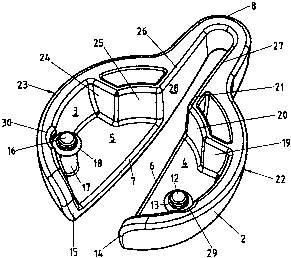Une partie des informations de ce site Web a été fournie par des sources externes. Le gouvernement du Canada n'assume aucune responsabilité concernant la précision, l'actualité ou la fiabilité des informations fournies par les sources externes. Les utilisateurs qui désirent employer cette information devraient consulter directement la source des informations. Le contenu fourni par les sources externes n'est pas assujetti aux exigences sur les langues officielles, la protection des renseignements personnels et l'accessibilité.
L'apparition de différences dans le texte et l'image des Revendications et de l'Abrégé dépend du moment auquel le document est publié. Les textes des Revendications et de l'Abrégé sont affichés :
| (12) Demande de brevet: | (11) CA 2320432 |
|---|---|
| (54) Titre français: | COUPE-CAPSULE |
| (54) Titre anglais: | FOIL CUTTER |
| Statut: | Réputée abandonnée et au-delà du délai pour le rétablissement - en attente de la réponse à l’avis de communication rejetée |
| (51) Classification internationale des brevets (CIB): |
|
|---|---|
| (72) Inventeurs : |
|
| (73) Titulaires : |
|
| (71) Demandeurs : |
|
| (74) Agent: | SMART & BIGGAR LP |
| (74) Co-agent: | |
| (45) Délivré: | |
| (22) Date de dépôt: | 2000-09-21 |
| (41) Mise à la disponibilité du public: | 2001-03-24 |
| Licence disponible: | S.O. |
| Cédé au domaine public: | S.O. |
| (25) Langue des documents déposés: | Anglais |
| Traité de coopération en matière de brevets (PCT): | Non |
|---|
| (30) Données de priorité de la demande: | ||||||
|---|---|---|---|---|---|---|
|
The foil cutter, in particular for wine bottles, has two halves, which are
connected together with a connecting part. The connecting part ensures a
resilient arrangement of the two halves. Provided between lateral parts and
cover
parts are resting surfaces for the neck of the wine bottle. These have, on the
one
hand, a support function, and, on the other hand, enable as little friction as
possible during turning. The cutting edges of the little cutting wheels held
on
mountings are disposed in such a way that they are turned toward the
mountings.
This facilitates easier placement on the bottle.
Note : Les revendications sont présentées dans la langue officielle dans laquelle elles ont été soumises.
Note : Les descriptions sont présentées dans la langue officielle dans laquelle elles ont été soumises.

2024-08-01 : Dans le cadre de la transition vers les Brevets de nouvelle génération (BNG), la base de données sur les brevets canadiens (BDBC) contient désormais un Historique d'événement plus détaillé, qui reproduit le Journal des événements de notre nouvelle solution interne.
Veuillez noter que les événements débutant par « Inactive : » se réfèrent à des événements qui ne sont plus utilisés dans notre nouvelle solution interne.
Pour une meilleure compréhension de l'état de la demande ou brevet qui figure sur cette page, la rubrique Mise en garde , et les descriptions de Brevet , Historique d'événement , Taxes périodiques et Historique des paiements devraient être consultées.
| Description | Date |
|---|---|
| Demande non rétablie avant l'échéance | 2006-09-21 |
| Le délai pour l'annulation est expiré | 2006-09-21 |
| Inactive : CIB de MCD | 2006-03-12 |
| Réputée abandonnée - omission de répondre à un avis sur les taxes pour le maintien en état | 2005-09-21 |
| Inactive : Abandon.-RE+surtaxe impayées-Corr envoyée | 2005-09-21 |
| Demande publiée (accessible au public) | 2001-03-24 |
| Inactive : Page couverture publiée | 2001-03-23 |
| Inactive : CIB en 1re position | 2000-12-01 |
| Demande reçue - nationale ordinaire | 2000-10-24 |
| Exigences de dépôt - jugé conforme | 2000-10-24 |
| Lettre envoyée | 2000-10-24 |
| Inactive : Certificat de dépôt - Sans RE (Anglais) | 2000-10-24 |
| Date d'abandonnement | Raison | Date de rétablissement |
|---|---|---|
| 2005-09-21 |
Le dernier paiement a été reçu le 2004-07-22
Avis : Si le paiement en totalité n'a pas été reçu au plus tard à la date indiquée, une taxe supplémentaire peut être imposée, soit une des taxes suivantes :
Veuillez vous référer à la page web des taxes sur les brevets de l'OPIC pour voir tous les montants actuels des taxes.
| Type de taxes | Anniversaire | Échéance | Date payée |
|---|---|---|---|
| Enregistrement d'un document | 2000-09-21 | ||
| Taxe pour le dépôt - générale | 2000-09-21 | ||
| TM (demande, 2e anniv.) - générale | 02 | 2002-09-23 | 2002-07-23 |
| TM (demande, 3e anniv.) - générale | 03 | 2003-09-22 | 2003-07-16 |
| TM (demande, 4e anniv.) - générale | 04 | 2004-09-21 | 2004-07-22 |
Les titulaires actuels et antérieures au dossier sont affichés en ordre alphabétique.
| Titulaires actuels au dossier |
|---|
| ZYLISS HAUSHALTWAREN AG |
| Titulaires antérieures au dossier |
|---|
| HANS WEIBEL |